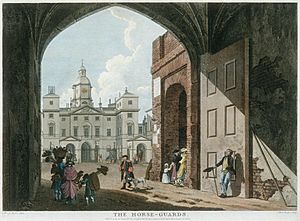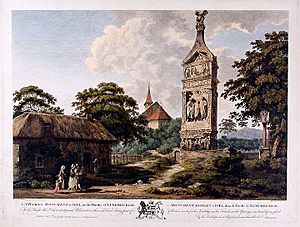Edward Rooker facts for kids

Edward Rooker (born around 1712 – died November 22, 1774) was a talented English engraver, a person who draws plans or sketches (draughtsman), and an actor. He was known for his detailed pictures of buildings and landscapes.
Life and Work

Edward Rooker was born in Towcester, a town in Northamptonshire, England, around the year 1712. He learned his skills from Henry Roberts, who was also an engraver specializing in landscapes. Edward Rooker became very famous for his engravings of buildings. These pictures were known for being very detailed and artistic. Some art experts even called him the "Marc Antonio" of architecture, meaning he was incredibly skilled at engraving buildings.
Some of Rooker's early works include a view of the Thames River from Somerset House (made in 1750). He also created a picture of Vauxhall Gardens (in 1751). Both of these were based on paintings by the famous artist Canaletto. He also engraved a view of the Parthenon for a book called 'Views of Sicily and Greece' (1751). Another important work was a detailed section of St. Paul's Cathedral (1755). This showed how the cathedral was originally planned by Sir Christopher Wren.
Rooker also helped create pictures for several important books. He contributed to Sir William Chambers' 'Civil Architecture' (1759) and 'Kew Gardens' (1763). He also worked on James Stuart's 'The Antiquities of Athens and Other Monuments of Greece' (1762). Another project was Robert Adam's 'Ruins of the Palace of Diocletian at Spalatro' (1764).
One of Rooker's best works is a series of six views of London. He engraved these in a style similar to the famous artist Piranesi. These pictures were based on drawings by Paul and Thomas Sandby. Rooker published these himself in 1766. In the same year, he drew and engraved a large picture of Blackfriars Bridge. This bridge was still being built at the time. He also engraved many landscapes based on paintings by artists like William Pars, Paul Sandby, and Richard Wilson.
Edward Rooker worked with his son, Michael Angelo Rooker, on the pictures for the 'Oxford Almanacks'. These were annual calendars, and they worked together on the headings from 1769 to 1775. Edward Rooker was one of the first members of the Incorporated Society of Artists. He showed his artwork with them from 1760 to 1768. His very last works were for the 'Copper Plate Magazine'. These were a series of landscapes and portraits that started appearing just a few months before he passed away.
Besides his art, Rooker was also an actor. He performed at the Drury Lane Theatre in London. He acted there between 1752 and 1774. He often played the role of the harlequin, a funny character in old plays.
Edward Rooker died on November 22, 1774, at his home in Great Russell Street in Bloomsbury, London. His son, Michael Angelo Rooker, also became a well-known artist and engraver. Another son, Edward Rooker Jr., was also an engraver.

